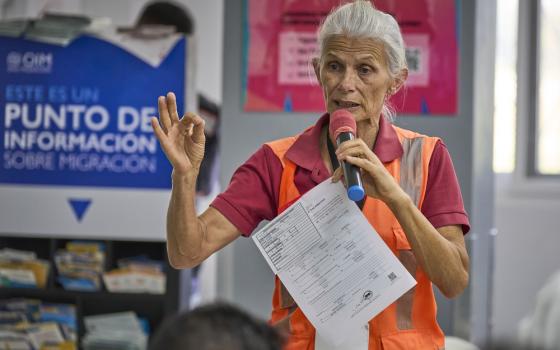
Children in Yangon, Myanmar, carry baskets loaded with gravel used for construction in 2015. (CNS/EPA/Rungroj Yongrit)
It's that special time of the year again when kids start heading back to school. And for those who have discovered the fun of learning, school is an adventure!
But for millions of working children worldwide, the adventures of a new school year remain but a dream. Sadly, these children will never learn to read or write. They will not acquire computer skills. They will not experience singing in chorus, going on field trips or playing at recess. Their classrooms will be sweatshops, farm fields and battlefields. Their days will be filled with long, dirty, dangerous work. And the lesson they will learn is that life is cruel and unfair.
According to the International Labor Organization (ILO), there are 152 million child laborers — ages 5-17 — worldwide. Child labor as defined by the ILO is work that is mentally, physically, socially or morally dangerous and harmful to children, and interferes with their schooling by depriving them of the opportunity to attend school, obliging them to leave school prematurely, or requiring them to attempt to combine school attendance with excessively long and heavy work.
Even worse, nearly half of all child laborers — approximately 73 million children — work in hazardous conditions.
According to the ILO, hazardous child labor includes working in dangerous conditions in agriculture, mining, construction, manufacturing, domestic service and bars. And it is found in both industrialized and economically developing countries.
It gets worse. Selling and trafficking of children, debt bondage and serfdom, forced recruitment of children for armed conflict, child prostitution, pornography, and drug activities are among the worst forms of labor millions of children are trapped in.
And according to the ILO, every year about 22,000 children are killed while working.
Advertisement
There is a direct relationship between poverty and child labor. In countless cases worldwide where families are struggling to put food on their table and keep a roof over their heads, there is usually no choice but to include their children in the workforce. And because children are low-skilled, have no one in authority to represent them, and are often docile, many unscrupulous employers exploit them.
In 1910, the United States had 2 million children working in industrial jobs. At that time, a leading advocate to abolish child labor, Grace Abbott, astutely observed: "Child labor and poverty are inevitably bound together and if you continue to use the labor of children as the treatment for the social disease of poverty, you will have both poverty and child labor to the end of time."
A wonderful U.S. government program that directly addresses a way out of poverty and child labor by giving poor children nourishment for both body and mind is the McGovern-Dole Food for Education Program. This program, a bipartisan international aid project that has provided school meals for more than 40 million of the world's poorest children, will be totally eliminated if Congress agrees with President Donald Trump's decision to defund it.
Please email and call (Capitol switchboard: 202-224-3121) your two U.S. senators and your congressperson, urging them to robustly increase funding for the McGovern-Dole Food for Education Program, and for all other international and domestic poverty-focused programs.
Child labor will not be eliminated until poverty is wiped away from the face of the earth.
[Tony Magliano is an internationally syndicated social justice and peace columnist. He is available to speak at diocesan or parish gatherings. Tony can be reached at tmag@zoominternet.net.]





